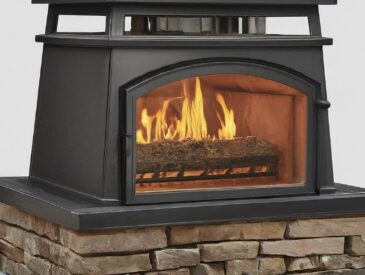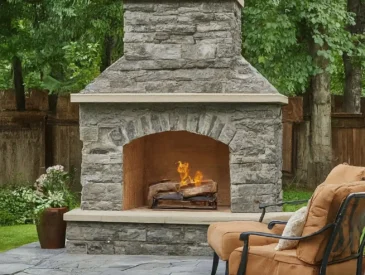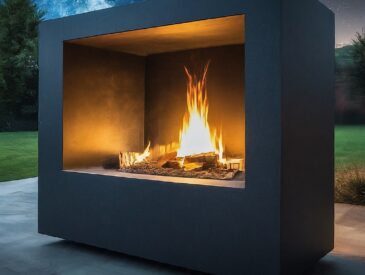Fireplaces add a special ambiance to any space, whether indoors or outdoors. While most indoor fireplaces are designed exclusively for indoor use,
there are exceptions. Some models are specially rated for outdoor use and equipped with built-in weather protection. The key lies in the specific model and brand you choose for your fireplace.
In this article, we’ll delve into the crucial reasons why using an indoor fireplace outdoors is not advisable and explore the options available for fireplaces that seamlessly transition between indoor and outdoor settings.
Elevate your space with the perfect fireplace for your unique needs and preferences.
Using Fireplaces Indoor vs Outdoor What You Need to Know:
When it comes to fireplaces, it’s crucial to understand their designated use. In general, an indoor fireplace should not be used outdoors unless explicitly stated otherwise in the product’s manual or packaging.
Indoor fireplaces are purpose-built for controlled indoor environments, using specific materials and designs tailored for home use.
Outdoor fireplaces, on the other hand, are constructed to withstand a range of environmental elements.
They are engineered to brave various weather conditions, making them suitable for outdoor spaces.
The differences between indoor and outdoor fireplaces are significant. For instance, indoor fireplaces may incorporate more luxurious materials like marble due to the controlled indoor setting.
Related: indoor and outdoor fireplace
Moreover, most indoor fireplaces are fixed installations, either built into the wall or connected to gas or electricity, making them less portable.
In contrast, electric fireplaces offer more flexibility for outdoor use, as they are generally more portable.
However, it’s essential to note that electric fireplaces may require protection from elements like rain and snow when used outdoors.
For those seeking a fireplace versatile enough for both indoor and outdoor use, it’s imperative to choose a model explicitly designed for such a purpose.
One notable example is the Touchstone Sideline Indoor/Outdoor 80017 Wall Mounted Electric Fireplace, which comes with built-in weather protection.
Additionally, Remi offers a range of outdoor-rated electric fireplaces. For those looking for a heat-producing model suitable for outdoor use, the Amantii Panorama Series is an excellent choice.
Keep in mind that these models, while versatile, are more intricate and come with a higher price tag. Additionally, an outdoor cover is recommended for outdoor usage
It is crucial to adhere to the specified use guidelines for your fireplace. Using an indoor fireplace outdoors without explicit approval can lead to accelerated deterioration and pose potential safety risks.
Using Fireplaces Understanding Indoor vs. Outdoor Applications
Fireplaces are designed with specific environments in mind. Generally, it’s important to note that an indoor fireplace should not be utilized outdoors unless expressly indicated on the packaging or user’s manual.
Indoor and outdoor fireplaces are engineered differently to cater to their respective settings and demands.
Indoor fireplaces are tailored for controlled home environments and are often constructed with luxurious materials like marble. In contrast, outdoor fireplaces are built to endure varying weather conditions and environmental elements.
Most standard indoor fireplaces are not suitable for outdoor use due to significant differences in temperature,
exposure to the elements, and other environmental factors. Additionally, indoor fireplaces are typically fixed installations, either built into walls or requiring connections to gas or electricity.
Electric fireplaces offer greater flexibility for outdoor use, as they are generally more portable. However, it’s important to ensure they are protected from elements like rain and snow, and access to a standard wall outlet may not always be feasible outdoors.

When considering a fireplace for both indoor and outdoor use, select a model explicitly designed for such versatility.
The Touchstone Sideline Indoor/Outdoor 80017 Wall Mounted Electric Fireplace, for instance, comes equipped with built-in weather protection.
Outdoor-rated electric fireplaces are also available from Remi for those seeking options designed specifically for outdoor use.
For a model that produces heat and is suitable for the outdoors, consider the Amantii Panorama Series. Keep in mind that these models are more intricate and come with a higher price point. Additionally, an outdoor cover is recommended for outdoor use.
It is crucial to adhere to the specified use guidelines for your fireplace. Using an indoor fireplace outdoors without explicit approval can lead to accelerated deterioration and pose potential safety risks.
Indoor vs. Outdoor Fireplaces: Unveiling the Differences
The distinction between indoor and outdoor fireplaces lies in their purpose and design. Indoor fireplaces are crafted for interior spaces, providing heating functionality within the confines of your home.
In contrast, outdoor fireplaces are strategically placed in more open areas and equipped with built-in weather protection to withstand the elements.
While the primary disparity is their designated usage—one for indoor and the other for outdoor environments—there are several nuanced distinctions to consider.
Indoor fireplaces are typically installed in living rooms or dining spaces, serving as room heaters. Consequently, they often require a damper, a component not typically needed for outdoor fireplaces.
Chimney caps are a notable feature found in outdoor fireplaces but are generally unnecessary for indoor setups. These caps play a crucial role in windy conditions, preventing sparks and embers from dispersing.
Material selection is another key distinction. The controlled environment indoors allows for a wider range of material options. Conversely, outdoor fireplaces require materials that can withstand outdoor conditions.
Additionally, most outdoor fireplaces are traditional wood-burning models, whereas indoor options offer a broader array, including electric and gas-powered variants.
It’s important to emphasize that using an indoor fireplace outdoors is not recommended. Not only will it lead to faster wear and tear, but it also lacks essential safety features like a chimney cap.
On a positive note, outdoor fireplaces are generally more budget-friendly and cost-effective especially when utilizing traditional wood-burning models that don’t rely on gas or electricity.
Embracing Versatility: The Beauty of Indoor and Outdoor Fireplaces
An indoor/outdoor fireplace, a marvel of design, serves as a dual-purpose wall that seamlessly connects indoor and outdoor spaces.
With a transparent, see-through design, this fireplace offers functionality from both sides, creating a harmonious flow between the interior and exterior environments.
This unique fireplace concept redefines traditional placement. Instead of being positioned against a wall, it becomes the wall itself.
As a result, it extends its warmth and allure to both the indoor living area and the outdoor space beyond. When strategically placed on your patio, it’s akin to having two fireplaces in one, doubling the charm and comfort.
Beyond their functional attributes, indoor and outdoor fireplaces also serve as captivating windows, enhancing the overall ambiance of any living space.
For those who desire the luxury of both an indoor and outdoor fireplace but seek a practical and cost-effective solution, this innovative design is the perfect answer.





